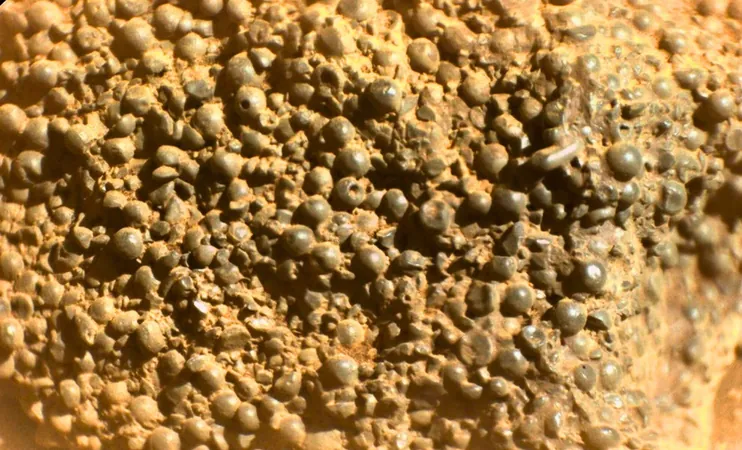
NASA's Perseverance Rover Unearths Mysterious Martian Rock: What Are These Hollow Spherules?
2025-03-28
Author: Yan
NASA's Perseverance Rover Unearths Mysterious Martian Rock: What Are These Hollow Spherules?
Earlier this month, NASA’s Perseverance rover made a groundbreaking discovery at the edge of Mars’ Jezero Crater, uncovering a rock containing an astonishing array of spherical formations that has left scientists pondering its origins. This intriguing rock could reshape our understanding of Mars’ geological history, raising profound questions about the planet’s ancient surface processes, which may include the influence of water, volcanic activity, and meteorite impacts.
A Rock Like No Other: The Discovery of St. Pauls Bay
On March 11, 2025, as it traversed the lower slopes of Witch Hazel Hill near Broom Point, the Perseverance rover came across a strange loose rock that would soon be dubbed St. Pauls Bay. Unlike any rock previously studied on Mars, it features hundreds of dark gray spherules—some nearly perfect in shape, while others are elongated or exhibit jagged edges. Notably, a few possess tiny pinholes that have caught the attention of planetary scientists.
Dr. Alex Jones, a PhD candidate at Imperial College London, expressed the collective curiosity surrounding the spherules: "What quirk of geology could produce these strange shapes?" The striking morphology of these spherules opens up both familiar and novel lines of inquiry regarding Mars' past environmental conditions.
Echoes of History: A Recurring Martian Mystery
This isn’t the first time peculiar spherical structures have been observed on Mars; in 2004, the Opportunity rover discovered formations known as “Martian blueberries” in Meridiani Planum. The Curiosity rover later encountered similar formations at Yellowknife Bay in Gale Crater. Just recently, Perseverance found popcorn-like spherules in Neretva Vallis, indicating a repeated pattern of these geological phenomena across Mars.
Scientists theorize that many of these formations are concretions—mineral nodules created by groundwater interacting with rock. However, the recent discovery at St. Pauls Bay presents an opportunity to explore alternative theories.
Dueling Hypotheses: Concretions vs. Volcanic/Impact Origins
There are two leading hypotheses regarding the formation of the strange spherules in St. Pauls Bay: 1. **Groundwater Interaction**: The spherules could be concretions formed by mineral deposition from fluids circulating underground, suggesting a long history of hydrological activity on Mars. If confirmed, this would bolster evidence of a wetter Mars in its ancient past. 2. **Volcanic or Impact Origin**: Alternatively, these structures might be volcanic droplets or melt fragments generated by explosive volcanic eruptions or meteorite impacts—processes that typically produce jagged forms in their aftermath.
Each hypothesis is laden with implications for understanding the geological history of Mars, and distinguishing between them has become a pressing scientific objective.
A Window into Mars' Past: Is This an Ancient Fragment?
The rock being studied is categorized as a “float rock,” which indicates it is not situated in its original position and may have been displaced. NASA's science team suggests it may have originally come from one of the darker strata visible in Witch Hazel Hill. If validated, this connection could provide insight into ancient geological layers that remain unexamined.
Gwenaël Caravaca, a French geologist involved in both the Curiosity and Mars 2020 missions, underscored the importance of this site, stating, "These terrains outside the crater are among the oldest ever explored on Mars—dating back more than 3.7 billion years." The exploration by Perseverance into areas beyond the main Jezero crater may reveal pristine geological features that have evaded the erosive forces present within the crater itself.
Caravaca further emphasizes that whether these spherules are the result of fluid interactions or volcanic processes, they likely predate the formation of the Jezero crater itself, suggesting their origins trace back to an era when liquid water may have shaped the Martian landscape.
The Ongoing Quest for Understanding
NASA scientists are meticulously working to match the mineral-rich St. Pauls Bay rock with particular geological layers in Witch Hazel Hill. Establishing such connections is critical for reconstructing the historical geology of the region, revealing whether the spherules formed in environments characterized by water, volcanic activity, or other unexplored phenomena.
"Placing these features in geologic context will be critical for understanding their origin," NASA notes, highlighting the broader implications this research holds for interpreting the evolutionary history of Mars—not merely within the confines of Jezero Crater, but across the ancient terrains that surround it.
As curiosity mounts and more examinations transpire, the Martian spherules may soon reveal secrets that could enlighten our understanding of the Red Planet's enthralling past. Will these findings redefine our quest for knowledge about Mars? Stay tuned for the next clickbait update!




 Brasil (PT)
Brasil (PT)
 Canada (EN)
Canada (EN)
 Chile (ES)
Chile (ES)
 Česko (CS)
Česko (CS)
 대한민국 (KO)
대한민국 (KO)
 España (ES)
España (ES)
 France (FR)
France (FR)
 Hong Kong (EN)
Hong Kong (EN)
 Italia (IT)
Italia (IT)
 日本 (JA)
日本 (JA)
 Magyarország (HU)
Magyarország (HU)
 Norge (NO)
Norge (NO)
 Polska (PL)
Polska (PL)
 Schweiz (DE)
Schweiz (DE)
 Singapore (EN)
Singapore (EN)
 Sverige (SV)
Sverige (SV)
 Suomi (FI)
Suomi (FI)
 Türkiye (TR)
Türkiye (TR)
 الإمارات العربية المتحدة (AR)
الإمارات العربية المتحدة (AR)